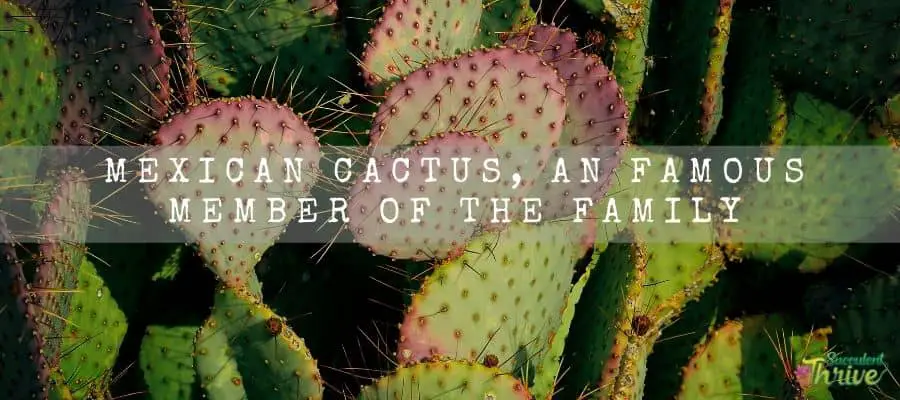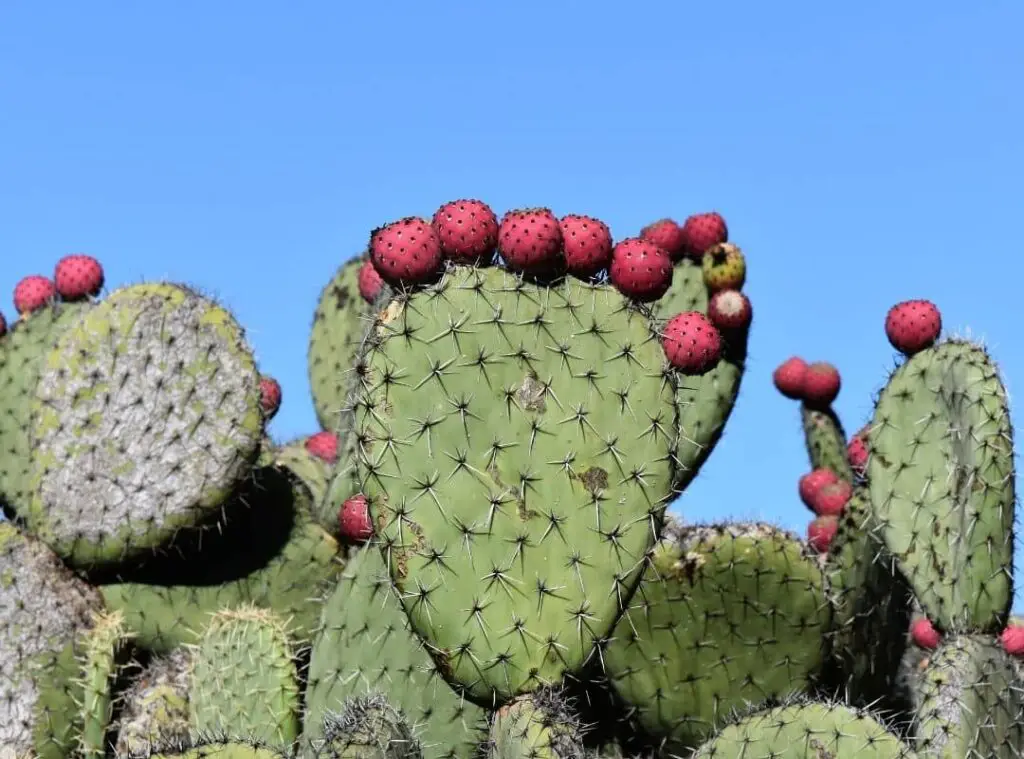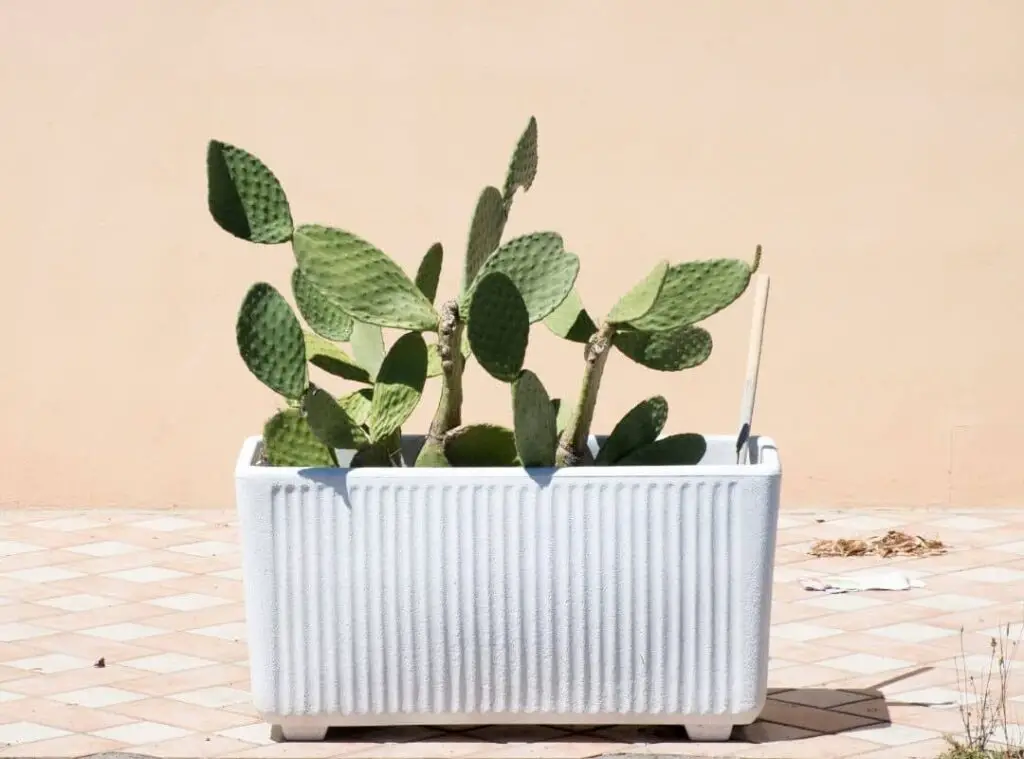Mexican cacti go by the common name “prickly pear cactus,” and it is a famous plant among succulent enthusiasts. Mexican cacti have their own unique beauty. They are known as “Mexican cactus” because of their segmented, flat, and oval stems.

Even though their name sounds very soothing, you need to beware when dealing with the plants as they contain large round spines. These cacti are endemic plants to the USA, and they have adapted to grow in dry weather conditions. Mexican cactus can also conserve water just like other cacti and succulents.
This characteristic makes them thrive well in drought conditions. In addition to that, their low maintenance makes them great choices for newbie gardeners. So brace yourself and get ready to discover these amazing plants.
One look care guide
| Botanical Name | Opuntia sp |
| Common Name | Mexican cactus |
| Plant Type | Cactus |
| Mature Size | Maximum height from one feet – 6-7 feet |
| Sun Exposure | Full sunlight |
| Soil Type | Well-draining |
| Soil pH | Alkaline to neutral |
| Bloom Time | Spring summer |
| Flower Color | Yellow, red and in purple colors |
| Hardiness Zones | USDA hardiness zones 9-11 mainly |
| Native Area | USA |
| Toxicity | Toxic |
| Average price | 7 USD |
How do I identify Mexican cactus?
They comprise segmented stems which tend to take flat and oval shape as aforesaid. Further you could spot those stems emerging with dots on both sides of the stems.
Mexican cacti have large round spines as well. Besides, they may carry tiny hairs too. Mexican cactus leaves are somewhat modified, and they would form out of the tubercles, which are small and look like wart-like projections. Mexican cacti produce flowers in summer. Further, those blooms will form along the ridge of the stems. You could spot most of these flowers emerging in yellow, red, and purple colors.
They may grow to different heights. It could be from one foot to six to seven feet in height. Mexican cactus pads can also differ in size, color, and shape. Mexican cacti produce fruits in different colors as well. In fact, they would form in shades of red, green, and yellow-orange.
How do you take care of Mexican cactus?
Light Requirement
Mexican cactus has strong sunlight requirements, which are more like the rest of other succulents and cacti. Literally, you need to expose the plants to full sunlight in the morning and partial shade in the intense hours of summer. When grown outdoors, on the other hand, a bright, sunny windowsill would be ideal.
Temperature and humidity
Mexican cactus has adapted to growing in hot, dry conditions. Thus, when you cultivate them, you need to mimic the same conditions that they get in their natural habitats. In a nutshell, they must be exposed to warmer temperatures throughout. They would not tolerate temperatures that went beyond 14 degrees Fahrenheit.
If you have grown them in pots and if you have kept them outdoors, you may consider bringing them indoors to protect them from frost and extreme winter conditions.

Is it cold hardy?
Mexican cactus are cold hardy to some extent.
Grow Zone
Mexican cactus preferred USDA hardiness zones are 9-11. Having said that there are certain Mexican cactus which are hardy in hardiness zones 4 as well.
Watering Requirement
Mexican cactus used to grow in hot and dry conditions. They can survive in drought conditions for extended periods as well. You can consider watering them once every two to four weeks when they are actively growing in the summer. On the other hand, they can thrive with just once a month of watering in the winter and fall.
If you have grown them somewhere where they get rainfall consistently, you can skip watering them. However, if you spot the soil is bone dry, you need to commence watering them immediately.
Soil Requirement Type / pH
First of all, a soil mix with an alkaline to neutral pH level would be beneficial for the healthy growth of the Mexican cactus. With that being said, what is more crucial in the soil mix is to check whether it has excellent drainage. If the moisture is retained in the soil mix, it will lead to root rot and make the plants more vulnerable to bacterial and fungal infections.
Aside from good drainage, good aeration is another factor to consider when choosing the right soil mix. Considering all these, what I would recommend you do is go ahead with a commercially made succulent or cactus soil mix to grow them.
Pot size Potting and Repotting
Ideally, you should choose a pot made of a porous material that will evaporate excess moisture quickly. In addition to that, it needs to have one or two draining holes too. When it comes to repotting the plants, you need to do it with so much care because if you do it without caution, chances are that it will affect them badly.
Further, keep in mind that you need to wear thick gloves as well as long sleeves so that the spines of the plants will not injure you. Aside from that, when repotting the plants, you must replant them in the same depth in the new pot.
Where to Plant
Mexican cactus will grow healthily if you grow them in a warm, sunny spot. Further, make sure that you protect the plants from strong direct sunlight as well. Moreover, you need to relocate the plants to a cooler place during the winter so that it will encourage the flowering.
Fertilizer and time of year
When it comes to feeding your Mexican cactus, you may consider choosing a balanced 10-10-10 fertilizer to feed them. If you have a well-established Mexican cactus, a 5-10-10 or 10-10-10 water soluble fertilizer would be ideal. That would help the plants produce new flowers as well as fruits. However, if you grow the Mexican cactus mainly for the pads, I recommend going ahead with a fertilizer that has a low percentage of nitrogen.
Flower
These cactus produce flowers in yellow, red and in purple colors and you could spot those flowers emerging in spring summer.

Dormancy
Mexican cactus is dormant in winter.
Toxicity
Mexican cactus could be toxic and result in side effects. In fact, you may suffer from diarrhea, nausea, bating and even heartburn.
Common bugs and illnesses
Mexican cactus may suffer from shriveled leaves if you deprive them of sufficient watering. Despite the fact that they are drought-tolerant plants, they still need sufficient water to thrive. On the other hand, providing them with too much water will cause the plants to rot. If the rot gets severe, you may want to repot the plants.
Having said that, if the rot has spread on a massive scale, chances are that it may kill your plants as well. In addition to that, if you spot that your Mexican cactus has developed sunburns, you need to immediately shift the plants to a shady place, which would help them recover.
Further overwatering may make the Mexican cactus split as well. In that case, you should water them as little as possible to allow the scars to heal. When it comes to bugs attacks, Mexican cactus may experience scale insects more often. If you spot any brown lumps on the plants, it could be due to scale infestations.
If you ever come across any, you need to wipe them off with a brush. Alternatively, you may wash them with a cloth soaked in organic insecticide too. Besides, scale mealybugs could also be troublesome for the Mexican cactus. If you see any white fluffy spots, they are most likely mealybugs.
Special Care tips
You do not need to bother pruning Mexican cactus. However, if you wish to maintain the pad sizes, you could consider giving them a small trim. Use the tongs and hold the pad when you trim them. Next, take a sharp, disinfected knife and cut it off at the joint. In addition to that, it is very important that you expose them to sufficient sunlight and grow them in a well-draining soil mix, too.
Benefits
There is some Mexican cactus where you can consume the fruits and the pads of them. In addition to that they would make great outdoor plants as well.

How to propagate Mexican cactus?
You can propagate the Mexican cactus by using either seeds or cuttings. However, I recommend going ahead with the cutting method, as it is very simple to do. So, to do that, you need to first select a healthy stem piece that is about 10 cm in length. After that, leave them on a windowsill, which will allow them to callous over.
Next, fill a pot with the cactus compost and place the cutting bases in the pots. When you plant them, ensure that they are planted at a depth of about 2 cm. Next, you can water them as appropriate and leave them exposed to bright, indirect sunlight. Avoid covering them with plastic bags or keeping them in propagators. If the soil is dry, you need to water them.
Conclusion
Mexican cactus are such versatile soothing plants to have. So, I hope this article made you excited to have a Mexican cactus and now that you are well equipped with the knowledge in handling them. So happy gardening with Mexican cactus !
Read Next : Epithelantha Micromeris | A Beautiful Fur Ball |
